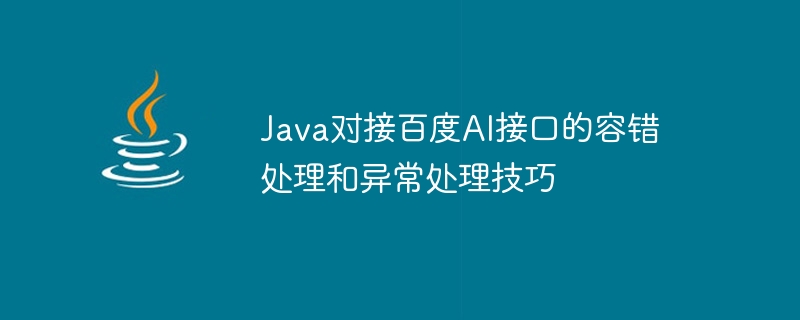Home >Java >javaTutorial >Fault tolerance and exception handling techniques for connecting Java to Baidu AI interface
Fault tolerance and exception handling techniques for connecting Java to Baidu AI interface
- WBOYWBOYWBOYWBOYWBOYWBOYWBOYWBOYWBOYWBOYWBOYWBOYWBOriginal
- 2023-08-27 10:25:481060browse

Fault tolerance and exception handling skills for Java docking Baidu AI interface
Summary:
During the development process, it is very important to dock third-party API interfaces One of the common tasks. When using Baidu AI interface, how to perform fault tolerance and exception handling is an important skill. This article will introduce some common fault-tolerance and exception handling techniques when connecting to Baidu AI interface in Java, and give corresponding code examples. I hope this article can be helpful to everyone in actual development.
1. Fault-tolerance processing skills
1.1 Handling network timeout:
When using the Baidu AI interface, request timeouts may occur due to various reasons such as the network. In order to avoid blocking the entire system due to network timeout, we can set a timeout period for the request and use the try-catch statement to catch the timeout exception. The sample code is as follows:
import java.net.SocketTimeoutException;
public class APIDemo {
public static void main(String[] args) {
try {
// 设置超时时间为5秒
RequestConfig requestConfig = RequestConfig.custom()
.setConnectTimeout(5000)
.setConnectionRequestTimeout(5000)
.setSocketTimeout(5000)
.build();
// 创建HttpClient对象,并设置超时配置
CloseableHttpClient httpClient = HttpClientBuilder.create()
.setDefaultRequestConfig(requestConfig)
.build();
// 发送请求,并处理响应
HttpGet request = new HttpGet("http://api.baidu.com");
CloseableHttpResponse response = httpClient.execute(request);
// 处理响应
} catch (SocketTimeoutException e) {
// 处理超时异常
} catch (IOException e) {
// 处理其他IO异常
}
}
}1.2 Processing request parameters is illegal:
When connecting to Baidu AI interface, we need to set the request parameters according to the interface requirements. However, sometimes we may pass in illegal parameters, causing the request to fail. To avoid this, we can check the parameters before requesting and throw a custom exception if necessary. The sample code is as follows:
import java.util.regex.Pattern;
public class APIDemo {
public static void main(String[] args) {
String content = "Hello, World!";
// 检查参数是否包含非法字符
if (!Pattern.matches("^[a-zA-Z0-9]+$", content)) {
throw new IllegalArgumentException("参数包含非法字符");
}
// 继续发送请求,处理响应
}
}2. Exception handling skills
2.1 Capture exceptions returned by Baidu AI interface:
When connecting to Baidu AI interface, we need to follow the interface document provisions exception type for exception handling. When using Baidu AI SDK, BaiduApiException is usually thrown. We can capture the exception to obtain detailed exception information and handle it as needed. The sample code is as follows:
import com.baidu.aip.error.AipError;
import com.baidu.aip.error.AipException;
import com.baidu.aip.speech.AipSpeech;
public class APIDemo {
public static void main(String[] args) {
// 创建AipSpeech对象
AipSpeech client = new AipSpeech(APP_ID, API_KEY, SECRET_KEY);
try {
// 调用接口
JSONObject result = client.asr(fileData, "pcm", 16000, null);
// 解析响应
} catch (AipException e) {
// 处理异常
AipError error = e.getErrorCode();
System.out.println("错误码:" + error.getCode());
System.out.println("错误信息:" + error.getMsg());
}
}
}2.2 Custom exception handler:
When connecting to Baidu AI interface, we can also customize the exception handler according to specific business needs. By customizing exception handlers, we can implement personalized handling of different types of exceptions. The sample code is as follows:
import com.baidu.aip.error.AipError;
import com.baidu.aip.error.AipException;
import com.baidu.aip.speech.AipSpeech;
public class APIDemo {
public static void main(String[] args) {
// 创建AipSpeech对象
AipSpeech client = new AipSpeech(APP_ID, API_KEY, SECRET_KEY);
// 设置自定义异常处理器
client.setExceptionHandler(new AipExceptionHandler() {
@Override
public void handle(AipError error) {
// 处理异常
System.out.println("错误码:" + error.getCode());
System.out.println("错误信息:" + error.getMsg());
}
});
try {
// 调用接口
JSONObject result = client.asr(fileData, "pcm", 16000, null);
// 解析响应
} catch (AipException e) {
// 处理异常
}
}
}This article introduces the fault tolerance and exception handling techniques for connecting Baidu AI interface in Java, and gives corresponding code examples. I hope this article can be helpful to everyone in actual development.
References:
- Baidu AI development documentation: http://ai.baidu.com/docs
- Baidu AI Java SDK: https://github .com/Baidu-AIP/java-sdk
The above is the detailed content of Fault tolerance and exception handling techniques for connecting Java to Baidu AI interface. For more information, please follow other related articles on the PHP Chinese website!

